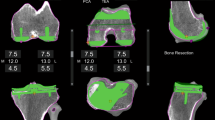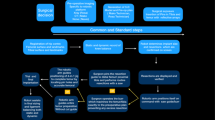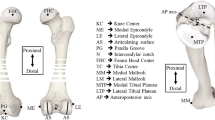Abstract
Introduction
The ROSA (Robotic Surgical Assistant) Knee system (Zimmer Biomet, Warsaw, IN) for total knee arthroplasty (TKA) can be considered as collaborative robotics, where the surgeon remains in charge of the procedure and collaborates with a smart robotic tool, to perform the surgery with a high accuracy and reproducibility. The aim was to describe: (1) its concept and surgical technique; (2) its advantages and potential limits; (3) the early experience with this system.
Materials and methods
The goal during its development phase was to keep the surgeon active and at the center of the operation: the surgeon handles the saw and performs the cuts while the robotic arm places and holds the guide at the right place. The ROSA knee platform assists the surgeon for the distal femoral cut, the femoral component sizing and positioning, the tibial cut and the ligament balance. This robotic system has two options: image-based with 3D virtual model; or image-less, based on intraoperative landmarks acquisition. All the classic surgical techniques can be used: measured resection, gap balancing, functional alignment, kinematic alignment. Some techniques recently developed are more ROSA-specific: Robotic personalized TKA, ROSA-FuZion technique.
Results
Its advantages as compared to other available systems include: radiographs in standing position, collaborative robotic system where the robot completes the surgeon skills, “off-the-shelf” implants, predictive robotic with concept of machine learning incorporated into the system. Two cadaveric studies have reported the high accuracy and reproducibility of this device. This robotic system is recent and currently no clinical series has enough follow-up to report clinical outcomes.
Conclusion
The ROSA knee system is a robotically assisted semi-autonomous surgical system with some specific characteristics. The aim of this collaborative robotic system is to improve the accuracy and reliability of the bone resections and the ligament balancing, without replacing the steps well performed by the surgeon.





Similar content being viewed by others
References
Hetaimish BM, Khan MM, Simunovic N, Al-Harbi HH, Bhandari M, Zalzal PK (2012) Meta-analysis of navigation vs conventional total knee arthroplasty. J Arthroplasty 27(6):1177–1182. https://doi.org/10.1016/j.arth.2011.12.028
Courtney PM, Lee GC (2017) Early outcomes of kinematic alignment in primary total knee arthroplasty: a meta-analysis of the literature. J Arthroplasty 32(6):2028–2032. https://doi.org/10.1016/j.arth.2017.02.041
Lee BS, Cho HI, Bin SI, Kim JM, Jo BK (2018) Femoral component varus malposition is associated with tibial aseptic loosening after TKA. Clin Orthop Relat Res 476(2):400–407. https://doi.org/10.1007/s11999.0000000000000012
Batailler C, Swan J, Sappey Marinier E, Servien E, Lustig S (2020) New technologies in knee arthroplasty: current concepts. J Clin Med. https://doi.org/10.3390/jcm10010047
Liow MH, Chin PL, Tay KJ, Chia SL, Lo NN, Yeo SJ (2014) Early experiences with robot-assisted total knee arthroplasty using the DigiMatch ROBODOC(R) surgical system. Singap Med J 55(10):529–534. https://doi.org/10.11622/smedj.2014136
Bellemans J, Vandenneucker H, Vanlauwe J (2007) Robot-assisted total knee arthroplasty. Clin Orthop Relat Res 464:111–116. https://doi.org/10.1097/BLO.0b013e318126c0c0
Song EK, Seon JK, Park SJ, Jung WB, Park HW, Lee GW (2011) Simultaneous bilateral total knee arthroplasty with robotic and conventional techniques: a prospective, randomized study. Knee Surg Sports Traumatol Arthrosc 19(7):1069–1076. https://doi.org/10.1007/s00167-011-1400-9
Song EK, Seon JK, Yim JH, Netravali NA, Bargar WL (2013) Robotic-assisted TKA reduces postoperative alignment outliers and improves gap balance compared to conventional TKA. Clin Orthop Relat Res 471(1):118–126. https://doi.org/10.1007/s11999-012-2407-3
Hampp EL, Chughtai M, Scholl LY, Sodhi N, Bhowmik-Stoker M, Jacofsky DJ et al (2019) Robotic-arm assisted total knee arthroplasty demonstrated greater accuracy and precision to plan compared with manual techniques. J Knee Surg 32(3):239–250. https://doi.org/10.1055/s-0038-1641729
Marchand RC, Sodhi N, Khlopas A, Sultan AA, Harwin SF, Malkani AL et al (2017) Patient satisfaction outcomes after robotic arm-assisted total knee arthroplasty: a short-term evaluation. J Knee Surg 30(9):849–853. https://doi.org/10.1055/s-0037-1607450
Smith AF, Eccles CJ, Bhimani SJ, Denehy KM, Bhimani RB, Smith LS et al (2019) Improved patient satisfaction following robotic-assisted total knee arthroplasty. J Knee Surg. https://doi.org/10.1055/s-0039-1700837
Batailler C, Fernandez A, Swan J, Servien E, Haddad FS, Catani F et al (2020) MAKO CT-based robotic arm-assisted system is a reliable procedure for total knee arthroplasty: a systematic review. Knee Surg Sports Traumatol Arthrosc. https://doi.org/10.1007/s00167-020-06283-z
Collins K, Agius PA, Fraval A, Petterwood J (2021) Initial experience with the NAVIO robotic-assisted total knee replacement-coronal alignment accuracy and the learning curve. J Knee Surg. https://doi.org/10.1055/s-0040-1722693
Bollars P, Boeckxstaens A, Mievis J, Kalaai S, Schotanus MGM, Janssen D (2020) Preliminary experience with an image-free handheld robot for total knee arthroplasty: 77 cases compared with a matched control group. Eur J Orthop Surg Traumatol 30(4):723–729. https://doi.org/10.1007/s00590-020-02624-3
Miller BA, Salehi A, Limbrick DD Jr, Smyth MD (2017) Applications of a robotic stereotactic arm for pediatric epilepsy and neurooncology surgery. J Neurosurg Pediatr 20(4):364–370. https://doi.org/10.3171/2017.5.PEDS1782
De Benedictis A, Trezza A, Carai A, Genovese E, Procaccini E, Messina R et al (2017) Robot-assisted procedures in pediatric neurosurgery. Neurosurg Focus 42(5):7. https://doi.org/10.3171/2017.2.FOCUS16579
Jacofsky DJ, Allen M (2016) Robotics in arthroplasty: a comprehensive review. J Arthroplasty 31(10):2353–2363. https://doi.org/10.1016/j.arth.2016.05.026
Ponzio DY, Lonner JH (2015) Preoperative mapping in unicompartmental knee arthroplasty using computed tomography scans is associated with radiation exposure and carries high cost. J Arthroplasty 30(6):964–967. https://doi.org/10.1016/j.arth.2014.10.039
Parratte S, Price AJ, Jeys LM, Jackson WF, Clarke HD (2019) Accuracy of a new robotically assisted technique for total knee arthroplasty: a cadaveric study. J Arthroplasty 34(11):2799–2803. https://doi.org/10.1016/j.arth.2019.06.040
Seidenstein A, Birmingham M, Foran J, Ogden S (2020) Better accuracy and reproducibility of a new robotically-assisted system for total knee arthroplasty compared to conventional instrumentation: a cadaveric study. Knee Surg Sports Traumatol Arthrosc. https://doi.org/10.1007/s00167-020-06038-w
Insall J, Scott WN, Ranawat CS (1979) The total condylar knee prosthesis. A report of two hundred and twenty cases. J Bone Joint Surg Am 61(2):173–180
Masse V, Ghate RS (2021) Using standard X-ray images to create 3D digital bone models and patient-matched guides for aiding implant positioning and sizing in total knee arthroplasty. Comput Assist Surg (Abingdon) 26(1):31–40. https://doi.org/10.1080/24699322.2021.1894239
Bizzozero P, Bulaid Y, Flecher X, Ollivier M, Parratte S, Argenson JN (2018) Morphometric tibial implant decreases posterior overhang rate and improves clinical outcomes: results of a prospective, matched controlled study. J Arthroplasty 33(9):2804–2809. https://doi.org/10.1016/j.arth.2018.04.020
Stulberg SD, Goyal N (2015) Which tibial tray design achieves maximum coverage and ideal rotation: anatomic, symmetric, or asymmetric? An MRI-based study. J Arthroplasty 30(10):1839–1841. https://doi.org/10.1016/j.arth.2015.04.033
Dai Y, Scuderi GR, Bischoff JE, Bertin K, Tarabichi S, Rajgopal A (2014) Anatomic tibial component design can increase tibial coverage and rotational alignment accuracy: a comparison of six contemporary designs. Knee Surg Sports Traumatol Arthrosc 22(12):2911–2923. https://doi.org/10.1007/s00167-014-3282-0
Kim YH, Park JW, Lim HM, Park ES (2014) Cementless and cemented total knee arthroplasty in patients younger than fifty five years. Which is better? Int Orthop 38(2):297–303. https://doi.org/10.1007/s00264-013-2243-4
Bini SA, Shah RF, Bendich I, Patterson JT, Hwang KM, Zaid MB (2019) Machine learning algorithms can use wearable sensor data to accurately predict six-week patient-reported outcome scores following joint replacement in a prospective trial. J Arthroplasty 34(10):2242–2247. https://doi.org/10.1016/j.arth.2019.07.024
Kunze KN, Polce EM, Sadauskas AJ, Levine BR (2020) Development of machine learning algorithms to predict patient dissatisfaction after primary total knee arthroplasty. J Arthroplasty 35(11):3117–3122. https://doi.org/10.1016/j.arth.2020.05.061
Beldame J, Boisrenoult P, Beaufils P (2010) Pin track induced fractures around computer-assisted TKA. Orthop Traumatol Surg Res 96(3):249–255. https://doi.org/10.1016/j.otsr.2009.12.005
Scholes C, Sahni V, Lustig S, Parker DA, Coolican MR (2014) Patient-specific instrumentation for total knee arthroplasty does not match the pre-operative plan as assessed by intra-operative computer-assisted navigation. Knee Surg Sports Traumatol Arthrosc 22(3):660–665. https://doi.org/10.1007/s00167-013-2670-1
Lustig S, Scholes CJ, Oussedik S, Coolican MR, Parker DA (2014) Unsatisfactory accuracy with VISIONAIRE patient-specific cutting jigs for total knee arthroplasty. J Arthroplasty 29(1):249–250. https://doi.org/10.1016/j.arth.2013.05.020
Casper M, Mitra R, Khare R, Jaramaz B, Hamlin B, McGinley B et al (2018) Accuracy assessment of a novel image-free handheld robot for total knee arthroplasty in a cadaveric study. Comput Assist Surg (Abingdon) 23(1):14–20. https://doi.org/10.1080/24699322.2018.1519038
Jeon SW, Kim KI, Song SJ (2019) Robot-assisted total knee arthroplasty does not improve long-term clinical and radiologic outcomes. J Arthroplasty 34(8):1656–1661. https://doi.org/10.1016/j.arth.2019.04.007
Koulalis D, O’Loughlin PF, Plaskos C, Kendoff D, Cross MB, Pearle AD (2011) Sequential versus automated cutting guides in computer-assisted total knee arthroplasty. Knee 18(6):436–442. https://doi.org/10.1016/j.knee.2010.08.007
Funding
There is no funding source.
Author information
Authors and Affiliations
Corresponding author
Ethics declarations
Conflict of interest
CB: Grant from SoFCOT. DH: Consultant for Zimmer Biomet; Grants from Fondation pour la Recherche Ostéo-Articulaire. FB: Consultant for Zimmer Biomet and Limacorporate; Grants from Limacorporate; Royalties from Zimmer Biomet and Limacorporate. SP: Royalties from Zimmer Biomet and Newclip; Consultant for Zimmer Biomet; Treasurer for European Knee Society.
Ethical approval
This article does not contain any studies with human participants or animals performed by any of the authors.
Informed consent
Not applicable.
Additional information
Publisher's Note
Springer Nature remains neutral with regard to jurisdictional claims in published maps and institutional affiliations.
Rights and permissions
About this article
Cite this article
Batailler, C., Hannouche, D., Benazzo, F. et al. Concepts and techniques of a new robotically assisted technique for total knee arthroplasty: the ROSA knee system. Arch Orthop Trauma Surg 141, 2049–2058 (2021). https://doi.org/10.1007/s00402-021-04048-y
Received:
Accepted:
Published:
Issue Date:
DOI: https://doi.org/10.1007/s00402-021-04048-y




